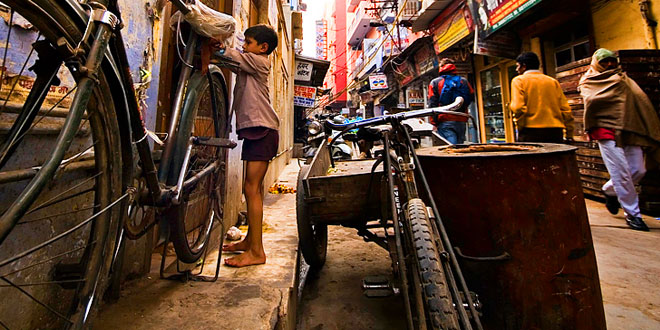Question: ‘A large city population was thus both a threat and an opportunity.’ Explain.
Answer: A large city population led to development of new means of transportation.
- A large city population provided a wide market to the industry.
- In the severe winter of 1886. when outdoor work came to a standstill, the London poor exploded in a riot, demanding relief from the terrible conditions of poverty. Alarmed shopkeepers closed down their establishments, fearing the 10,000-strong crowd that was marching from Deptford to London. The marchers had to be dispersed by the police.
- A similar not occurred in late 1SS7. This rime, it was brutally suppressed by the police in what came to be known as ihe Bloody Sunday of November 1887.
Question: “City development everywhere occurred at the expense of ecology”. Justify.
“City development everywhere occurred at the expense of ecology and the environment.” Explain.
Answer:
- To develop Cities natural features were flattened out or transformed in response to the growing demand for space tor factories, housing and other institutions.
- Large quantities of refuse and waste products polluted air and water, while excessive noise became a feature of urban life.
- The widespread use of coal in homes and industries in nineteenth century England raised serious problems. In industrial cities such as Leeds, Bradford and Manchester, hundreds of factory chimneys spewed black smoke into the skies.
- Shopkeepers, home owners and others complained about the black fog that descended on their towns, causing bad tampers, smoke-related illnesses, and dirty clothes.
- The vast mass of one room houses occupied by the poor wore a serious threat to public health.
Question: Describe in brief the development of Bombay (Mumbai) as the Prime city of India.
Answer:
- In the seventeenth century. Bombay was a group of seven islands under Portuguese control. In 1661. control of the islands passed into British hands after the marriage of Britain’s King Charles II to the Portuguese princess.
- The East India Company quickly shifted its base from Surat, its principal western port, to Bombay.
- At first Bombay was the major outlet for cotton textiles from Gujarat.
- Later, in the nineteenth century, the city functioned as a port through which large quantities of raw materials such as cotton and opium would pass.
- Gradually, it also became an important administrative centre in western India, and then, by the end of the nineteenth century, a major industrial centre.
- Bombay became the capital of the Bombay Presidency in 1819 after the Maratha defeat in the Anglo – Maratha war. The city quickly expanded. With the growth of trade in cotton and opium, large communities of traders and bankers as well os artisans and shopkeepers came to settle in Bombay. The establishment of textile mills led to a fresh surge ill migration.
Question: Explain the factors which led to the expansion of Bombay.
Or
Explain what led to the expansion of Bombay’s population in the mid 19th century.
Answer:
- Bombay as capital city: Bombay became the capital of the Bombay Presidency in 1519. after the Maratha defeat in the Anglo – Maratha war. The city quickly expanded. With the growth of trade in cotton and opium, large communities of traders and bankers as well as artisans and shopkeepers came to settle in Bombay.
- Industrialization: The establishment of textile mills led to a fresh surge in migration. The first cotton textile mill in Bombay was established in 1854. By 1921, there were So cotton mills with about 1,46,000 workers. Only about one-fourth of Bombay’s inhabitants between 1881 and 1931 were born in Bombay ,the rest came from outside. Large numbers flowed in from the nearby district of Ratnagiri to work in the Bombay mills.
- Introduction of railways: The first railway was introduced from Bombay to Thane in 1853 It was at the junction head of two major railways. The development of railway encouraged an even higher scale of migration into the city.
- Famines: Famines in the dry regions of Kutch drove large number of people into Bombay in 1888-89. The flood of migrants in some years created panic and alarm in official circles.
- Bombay as a film city: By 1925. Bombay had become India’s film capital. Most of the people in the film industry were themselves migrants who came from cities like Lahore. Calcutta. Madras, etc
Question: What were chawls? Mention major features of chawls.
Or
The chawls ol Bombay were a small cosmopolitan community in themselves. Explain.
Answer:
- Chawls were multistory structure had been built from atleast the l860s in the native parts of the town.
- Like the tenements in London, these houses were largely owned by private landlords, such as merchants, bankers, and building contractors, looking for quick ways of earning money from anxious migrants.
- Each chawl was divided into smaller one- room tenements which had no private toiler.
- There was an open space in the middle of chawls for social and cultural gatherings.
- People who belonged to the ‘depressed classes’ found it even more difficult to find housing. Lower castes were kept out of many chawls and often had to live in shelters made of corrugated sheets, leaves or bamboo poles.
 Class Notes NCERT Solutions for CBSE Students
Class Notes NCERT Solutions for CBSE Students





